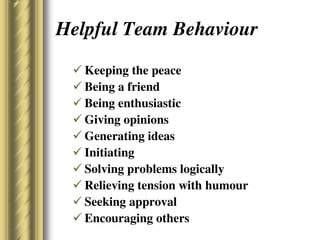Team building
- 2. What is team? In a team, People depend on each other; May or may not work in the same physical location, Combine to achieve something together
- 3. Team Building The process of working with a team to clarify its task and how team members can work together to achieve it. A strategy that can help groups to develop into a real team is “team building”
- 4. Key actions in Team Building Setting and maintaining the teams objectives and standards Involving the team as a whole in the achievement of objectives Maintaining the unity of the team Communicating efficiently with the team Consulting the team – members before taking any decisions
- 5. Stages of Team Growth Stage I: Forming - Provide clear direction to establish the team’s purpose, setting goals, etc., Stage II: Storming – Provide strong, hands-on leadership to keep people talking and task-focused Stage III: Norming – Codes of behaviour becomes established and an identifiable group culture emerges. People begin to enjoy each other’s company and appreciate each other’s contributions Stage IV: Performing – Teams that reach this stage achieve results easily and enjoyably. People work together well and can improve systems, solve problems and provide excellent customer service. Stage V: Adjourning – Temporary project team reaches this stage; celebrate their team’s achievements.
- 6. Helpful Team Behaviour Keeping the peace Being a friend Being enthusiastic Giving opinions Generating ideas Initiating Solving problems logically Relieving tension with humour Seeking approval Encouraging others
- 7. Key factors to successful performance of a team – S.C.O.R.E Strategy Clear Roles and Responsibility Open Communication Rapid Response Effective Leadership
- 8. Key factors to successful performance of a team – S.C.O.R.E Strategy: Shared purpose Clearly articulated values and ground rules Understanding of risks and opportunities facing the team Clear categorization of the overall responsibilities of the team Clear Roles and Responsibilities: Clear definition of roles and responsibilities Responsibility shared by all members Specific objectives to measure individual results
- 9. Key factors to successful performance of a team – S.C.O.R.E Open communication: Respect for individual differences Open communication environment among team members Rapid response: Rapid response to the team’s problems Effective management to change in the internal and external environment Effective Leadership: Team leader who is able to help members achieve the objective and build the team Team leader who can draw out and free up the skills of all team members, develop individuals
- 10. “Coming together is a beginning Keeping together is progress; and Working together is success”
- 11. Questions?











